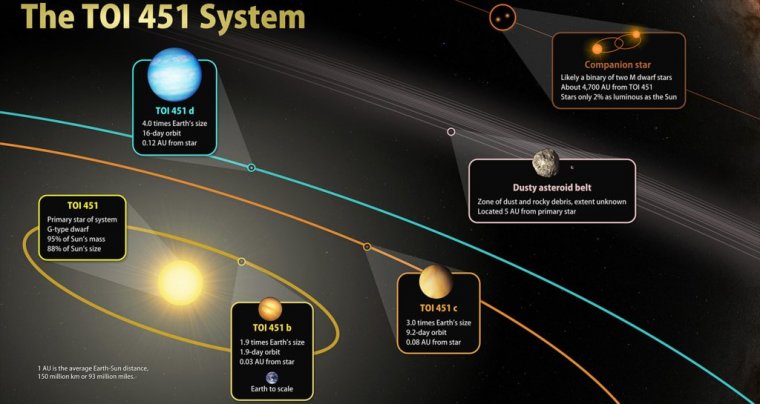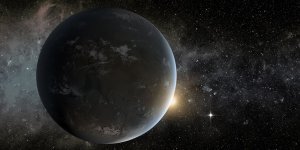| News / Space News |
NASA's TESS Discovers New Worlds in a River of Young Stars
Using observations from NASA’s Transiting Exoplanet Survey Satellite (TESS), an international team of astronomers has discovered a trio of hot worlds larger than Earth orbiting a much younger version of our Sun called TOI 451. The system resides in the recently discovered Pisces-Eridanus stream, a collection of stars less than 3% the age of our solar system that stretches across one-third of the sky.

This illustration sketches out the main features of TOI 451, a triple-planet system located 400 light-years away in the constellation Eridanus. Photo: NASA’s Goddard Space Flight Center
The planets were discovered in TESS images taken between October and December 2018. Follow-up studies of TOI 451 and its planets included observations made in 2019 and 2020 using NASA’s Spitzer Space Telescop.
Archival infrared data from NASA’s Near-Earth Object Wide-Field Infrared Survey Explorer (NEOWISE) satellite – collected between 2009 and 2011 under its previous moniker, WISE – suggests the system retains a cool disk of dust and rocky debris.
Other observations show that TOI 451 likely has two distant stellar companions circling each other far beyond the planets.
“This system checks a lot of boxes for astronomers,” said Elisabeth Newton, an assistant professor of physics and astronomy at Dartmouth College in Hanover, New Hampshire, who led the research.
“It’s only 120 million years old and just 400 light-years away, allowing detailed observations of this young planetary system. And because there are three planets between two and four times Earth’s size, they make especially promising targets for testing theories about how planetary atmospheres evolve.”
Stellar streams form when the gravity of our Milky Way galaxy tears apart star clusters or dwarf galaxies. The individual stars move out along the cluster’s original orbit, forming an elongated group that gradually disperses.
In 2019, a team led by Stefan Meingast at the University of Vienna used data from the European Space Agency’s Gaia mission to discover the Pisces-Eridanus stream, named for the constellations containing the greatest concentrations of stars. Stretching across 14 constellations, the stream is about 1,300 light-years long. However, the age initially determined for the stream was much older than we now think.
Later in 2019, researchers led by Jason Curtis at Columbia University in New York City analyzed TESS data for dozens of stream members. Younger stars spin faster than their older counterparts do, and they also tend to have prominent starspots – darker, cooler regions like sunspots.
As these spots rotate in and out of our view, they can produce slight variations in a star’s brightness that TESS can measure.
The TESS measurements revealed overwhelming evidence of starspots and rapid rotation among the stream’s stars. Based on this result, Curtis and his colleagues found that the stream was only 120 million years old – similar to the famous Pleiades cluster and eight times younger than previous estimates.
The mass, youth, and proximity of the Pisces-Eridanus stream make it an exciting fundamental laboratory for studying star and planet formation and evolution.
The young star TOI 451, better known to astronomers as CD-38 1467, lies about 400 light-years away in the constellation Eridanus. It has 95% of our Sun’s mass, but it is 12% smaller, slightly cooler, and emits 35% less energy. TOI 451 rotates every 5.1 days, which is more than five times faster than the Sun.
Even TOI 451’s most distant planet orbits three times closer than Mercury ever approaches to the Sun, so all of these worlds are quite hot and inhospitable to life as we know it. Temperature estimates range from about 2,200 degrees Fahrenheit (1,200 degrees Celsius) for the innermost planet to about 840 F (450 C) for the outermost one.
TOI 451 b orbits every 1.9 days, is about 1.9 times Earth’s size, and its estimated mass ranges from two to 12 times Earth’s. The next planet out, TOI 451 c, completes an orbit every 9.2 days, is about three times larger than Earth, and holds between three and 16 times Earth’s mass.
The farthest and largest world, TOI 451 d, circles the star every 16 days, is four times the size of our planet, and weighs between four and 19 Earth masses.
Observations from WISE show that the system is unusually bright in infrared light, which is invisible to human eyes, at wavelengths of 12 and 24 micrometers. This suggests the presence of a debris disk, where rocky asteroid-like bodies collide and grind themselves to dust.
While Newton and her team cannot determine the extent of the disk, they envision it as a diffuse ring of rock and dust centered about as far from the star as Jupiter is from our Sun.
The researchers also investigated a faint neighboring star that appears about two pixels away from TOI 451 in TESS images. Based on Gaia data, Newton’s team determined this star to be a gravitationally bound companion located so far from TOI 451 that its light takes 27 days to get there.
In fact, the researchers think the companion is likely a binary system of two M-type dwarf stars, each with about 45% of the Sun’s mass and emitting only 2% of its energy. (NASA)
YOU MAY ALSO LIKE





